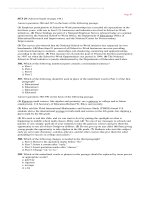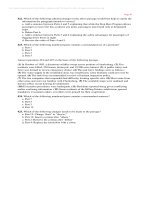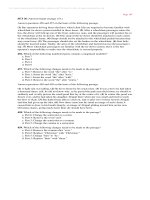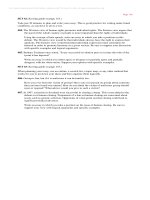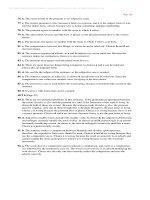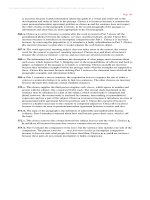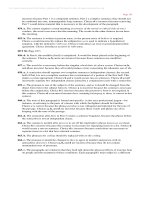501 grammar and writing 3e phần 8 doc
Bạn đang xem bản rút gọn của tài liệu. Xem và tải ngay bản đầy đủ của tài liệu tại đây (109.75 KB, 16 trang )
SET 52 (Scoring guide on pages 132–133.)
The essays in this set and the next few contain more
personal topics—ones that ask you to reflect on a
specific event in your life or on your personality.
492. Phyliss Bottome has said, “There are two ways
of meeting difficulties. You alter the difficulties
or you alter yourself to meet them.”
Write about a time in which you attempted
to alter a difficult situation, or decided to alter
yourself. Were you successful? Are you pleased
with the choice you made? Whichever you
chose to alter, would it have been easier to alter
the other? Would it have been better?
493. Bella Lewitzky once said, “To move freely you
must be deeply rooted.”
Write an essay in which you first state what
you interpret this statement to mean (there is
no right or wrong interpretation), then (using
your own interpretation) agree or disagree
with it. Support your opinion with specific
examples and logical reasoning.
SET 53 (Scoring guide on pages 132–133.)
Each body paragraph of your essay should have a
topic sentence that forecasts the main idea of that
paragraph. Make sure your topic sentences are con-
nected to your thesis statement in order to write a
unified essay.
494. Most people have faced a situation—perhaps
in a class, an organization, or just with a group
of friends—in which they held a strong, but
unpopular, opinion.
Write about a time when you were in this
circumstance. Did you speak up? Did you keep
quiet? Why do you think you made the choice
you did?
495. Do you consider yourself adventurous, a
risk-taker?
Write about a time in which you contem-
plated an undertaking which others considered
dangerous. Did you do it? Why? If you did not
do it, why not? Do you have regrets? The
danger involved need not have been physical,
although it could have been.
– ESSAY QUESTIONS–
100
SET 54 (Scoring guide on pages 132–133.)
It’s always important to explain yourself fully. How will
the reader understand the event you’re describing if
you don’t “show all”? In both personal and persuasive
writing, it’s important to include lots of details, images,
and explanations to support your main idea.
496. Nadine Stair said, “If I had my life to live
over again, I’d dare to make more mistakes
next time.”
Write an essay in which you agree or disagree
with this assessment, using your own life as a
touchstone. Why do you agree or disagree?
How might your life have been different if you
had dared to make more mistakes?
497. In the 1960s and 1970s, women were demanding
the right to attend previously all-male educational
institutions. Having won that right, some women
are now reconsidering. Citing studies that indicate
girls perform better in all-girl schools than in coed
schools, some women are calling for the establish-
ment of single-sex educational institutions.
Write an essay in which you take a position
on the issue of single-sex schools. Be sure to
include specific examples and solid reasoning
in your opinion.
SET 55 (Scoring guide on pages 132–133.)
Often the best way to organize a personal essay is
chronologically, in time order. But you should still make
sure you have a thesis statement that responds to the
question, and that your whole essay is related to your
thesis statement.
498. Susanne Curchod Necker said, “Worship your
heroes from afar; contact withers them.”
Do you agree? Write about a time when you
made contact with a hero. Were you disappointed
with the experience or not? Or, perhaps someone
once thought of you as a hero. Did they feel the
same way after they got close to you? Did close-
ness make the relationship better or worse?
499. Most of us have been in a situation, perhaps at
work or at school, in which we felt we were
being treated unfairly.
Write about a time when you were treated
unfairly. How did you react? What did you
do or say about the treatment? If you had it
to do over again, would you do something
differently?
– ESSAY QUESTIONS–
101
SET 56 (Scoring guide on pages 132–133.)
Whether you’re writing a personal essay or a persua-
sive one, make sure you stick to the topic you are given.
500. An old cliché says, “You can’t fight city hall.”
Do you believe this is true? What advice
would you give someone who wanted to
convince a city council that a stoplight should
be installed at a particular corner? Perhaps you
can write about a time in which you tried to
change or enact a law, or perhaps a regulation
at school or work. Were you successful? Why
or why not?
501. Advances in genetic testing now allow
scientists to identify people whose genetic
background makes them greater risks for
certain diseases. A genetic predisposition to a
certain disease, however, does not guarantee
that a patient will contract that disease.
Environmental factors, such as diet, exercise,
and smoking also play a role. Insurance
companies want to have access to genetic
information in order to help keep their costs
down. Opponents feel that insurance
companies will misuse such information, by
unfairly denying people coverage.
Write an essay in which you take a position
on providing genetic testing information to
insurance companies. Be sure to support
your argument with specific examples and
logical reasoning.
– ESSAY QUESTIONS–
102
Section 1: Mechanics
SET 1 (Page 3)
1. b. A title, such as Dr., requires a capital.
2. d. Nationalities and languages require capitals.
3. a. Jr. is a kind of title and therefore takes a capital.
4. b. The first letter of a direct quotation takes a capital.
5. e. Capitalization is correct.
6. a. All words in the proper name of a place require capitals.
7. b. Proper names require capitals.
8. c. Movie titles are capitalized.
SET 2 (Page 4)
9. d. There should be quotation marks before the word Coach to set off the dialogue.
10. d. Commas set off nonrestrictive appositives, phrases that say the same thing as the previous phrase, in
different words. (A comma should be placed after Patricia.)
11. a. A colon can go before a list. (Place a colon after the word flowers.)
12. a. A semicolon can be used to separate two main clauses, which could each stand alone as complete
sentences.
13.c. A dash can be used to set off a parenthetical element, for emphasis. (Place another dash after the
word senior.)
14. a. The possessive Kim’s requires an apostrophe.
15. e. This sentence is punctuated correctly.
16. b. Commas set off parenthetical elements and always go inside the quotation marks in a line of
dialogue. (Place a comma after the word remember.)
Answers
103
17. d. Commas set off a word or phrase that
describes the subject but does not alter the
meaning of the entire sentence. (Place a
comma after the word Larkin.)
18. c. A semicolon can be used to separate two
main clauses, which could each stand alone
as complete sentences. (Place the semicolon
after the word treadmill.)
SET 3 (Page 5)
19. b. The comma separates the main clause from
the long, descriptive subordinate clause.
20. d. The semicolon can be used to separate two
main clauses, which could each stand alone
as complete sentences.
21. a. The quotation is a question, and the tag
asked Timothy ends the sentence.
22. e. The sentence is punctuated correctly.
23. b. The word student’s is possessive and needs
an apostrophe.
24. e. The sentence does not require any
punctuation other than the period at the
end.
25. c. This is a declarative sentence; it asks an
indirect question, so a question mark
should not be used. Also, the comma is
unnecessary.
26. e. The sentence is punctuated correctly.
27. a. The phrase a root vegetable is a nonessential
element in the sentence and needs to be set
off with commas.
28. d. Commas separate dates and addresses.
SET 4 (Page 6)
29. a. Winter should not be capitalized.
30. c. There should not be an apostrophe after
the word girls.
31. a. The comma is unnecessary and should be
deleted.
32. b. Mayor should be capitalized because it
refers to a particular mayor.
33. c. Cape Cod is a proper noun, and both words
should be capitalized.
34. a. Since this is a declarative sentence, the
question mark should be replaced with
a period.
35. b. Uncle is not used as a proper noun and
should not be capitalized.
36. a. Grandma is used as a proper name and
should be capitalized.
37. b. A colon should not be used between a verb
and its objects.
38. a. There should be an apostrophe in the word
else’s, which is possessive.
39. c. The commas are missing from this series
of adjectives.
40. b. The quotation mark should appear on the
outside of the exclamation point: “Don’t run!”
41. c. Polio and smallpox should not be
capitalized. Diseases are not capitalized
unless a proper noun is part of the name.
42. a. Ocean should be capitalized.
43. c. To set off the dialogue, there should be
quotation marks before the word I’ll.
44. c. Mayor should not be capitalized because it
does not refer to a particular mayor.
45. b. A semicolon is not used between a
dependent and an independent clause. Use
a comma.
46. b. Veterinarian is not a proper noun and
should not be capitalized.
47. c. The word Why, which begins the
quotation, should be capitalized.
48. b. World War is a proper noun and should
be capitalized.
49. a. The phrase like many other viruses should
be set off by commas because it is a
nonessential element in the sentence.
50. a. Industrial Revolution should be capitalized.
51. a. The commas in this sentence should be
deleted. Commas are not used in a series
when the series is already linked by
conjunctions.
– ANSWERS–
104
52. a. The names of centuries are not capitalized.
53. c. This sentence asks a question and should
end with a question mark.
SET 5 (Page 8)
54. c. Commas are used to set off a word or
phrase that describes the subject but does
not alter the meaning of the entire
sentence.
55. e. The dash is used to set off parenthetical
elements, for emphasis.
56. a. The comma is used after an introductory
element.
57. b. The comma separates the main clause from
the descriptive subordinate clause.
58. c. Titles require capitals.
59. d. First word of salutations, titles, and proper
names all take capitals; a colon follows the
salutation in a business letter.
60. d. Commas set off parenthetical elements.
61. a. A comma goes before and when and links
two main clauses.
Section 2: Sentence Structure
SET 6 (Page 12)
62. d. Although means “despite the fact that” or
“even though.” Even though Sarah drives to
the cabin all the time, she still gets nervous.
The other choices do not convey this
meaning.
63. a. Therefore best completes the sentence’s
meaning; it creates a cause and effect
relationship between how Lila is feeling
(the cause) and her decision to stay home
from work (the effect).
64. b. While suggests that two things are
happening simultaneously; it is the only
logical choice. Choice a implies that Sam
could control when the doctor called him
in. Choices c and d are unclear.
65. c. The sentence requires a condition—Ruby
likes blueberry pie on one condition:
freshly picked blueberries. Choice b can be
ruled out because blueberry pie is not
always made with freshly picked
blueberries. Choices a and d result in
unclear sentences.
66. a. However indicates an impending
contradiction; it is the best choice because
the two clauses compare musical tastes. In
this case, the comparison contrasts
Mitchell’s preference to Greg’s.
67. d. If you rearrange the sentence, it would
read: If you sign up this week, you will
receive a low annual fee and a 20%
discount. In addition means and; it is the
best choice. Choices a, b, and c result in an
awkward construction.
68. b. The two clauses make a reference to time—
more specifically, to two different times.
Choice b is the only logical response.
69. d. The golden retriever is never outside
without a leash because the neighbor is
afraid of dogs; one is the effect of the other.
Consequently means following as an effect or
as a result. This is the best choice.
70. a. This sentence speculates that quilts were
made from fabrics taken from somewhere.
Only from completes this idea.
71. d. This is the only choice that results in a
complete and logical sentence. Choice a is
illogical; choices b and c result in sentence
fragments.
72. d.
The conditional tense, would have heard, is
the only one that logically fits with the
second clause of the sentence.
73. c. The Beatles songs specifically named were
pulled from a pool of titles. Only Among
suggests the existence of many other things,
in this case songs.
– ANSWERS–
105
SET 7 (Page 14)
74. c. Even though is the most logical subordinating
phrase, showing a contrast. The other
choices are not only illogical but
ungrammatical.
75. b. In this choice, the subordinate clause
makes sense. Choice b is also the least
wordy of the choices. In choices a and d,
the subordinators are illogical. Choice c
contains a misplaced modifier (Plato
believed; Plato’s idea could not believe).
76. a. The word despite establishes a logical
connection between the main and
subordinate clauses. Whereupon and so that
(choices b and c) make no sense. Choice d
is both illogical and ungrammatical.
77. c. The subordinator because in choice c
establishes the logical causal relationship
between subordinate and main clause;
choices a and b do not make sense. Choice
d has faulty construction.
78. b. Whereas (in choice b) is the logical
subordinator, establishing contrast. The
other answer choices make no sense.
79. b. The subordinators after (choice a),
whereupon (choice c), and unless (choice d)
do not make sense. Although the word but
(choice b) can be used as a coordinating
conjunction, here it is a subordinator,
logically connecting subordinate and
main clause.
80. c. The subordinator although shows a logical
contrasting relationship between
subordinate and main clause. The other
choices do not make sense.
81. b. The subordinator so (choice b) establishes
the correct causal relationship between
main and subordinate clause. The other
subordinators do not point to cause.
82. d. The subordinator yet establishes a
contrasting relationship between the main
and subordinate clauses. The other choices
do not establish a logical relationship.
83.
a. The subordinator whereas (choice a)
correctly establishes a contrast between
subordinate and main clause. The other
choices point to an illogical causal
relationship.
84. c. Choice a contains a misplaced modifier.
Choice b is a run-on sentence. Choice d
establishes a faulty causal relationship
between main and subordinate clauses.
Choice c correctly states a simple fact.
SET 8 (Page 17)
85. c. The conjunction but sets the reader up for a
contrast or opposite: TV passive (but)
computer game active.
86. b. The conjunction so indicates a causal
relationship: Socrates taught [something
obviously controversial], so he was . . .
both loved and . . . hated. Choice c is
incorrect because it has a misplaced
modifier.
87. a. The conjunction for in this sentence means
because and prepares the reader for a logical
causal relationship. Choice d is a run-on
sentence.
88. a. The conjunction so indicates that there is a
causal relationship between the two main
clauses.
89. d. The conjunction yet prepares the reader for
a contrast: respected, yet . . . imprisoned.
Choice b is wrong because it is unclear.
90. c. In this sentence, the conjunction for means
because and prepares the reader for a logical
causal relationship: new shoes . . . (for)
Donnie will be upset if . . . flip-flops.
– ANSWERS–
106
91. c. The conjunction so indicates a logical
causal relationship between the first main
clause and the second: loaded with money,
(so) she can afford.
92. b. The conjunction but sets the reader up for
an opposite or contrast: it is possible . . .
(but) unlikely. Choices c and d make
no sense.
93. c. The word Unless sets up the causal
relationship between the two clauses in the
sentence. The other choices are illogical.
94. a. The subordinating conjunction Although
signals an impending contradiction; it
makes the most sense. The other choices do
not make sense.
95. d. The subordinator but contrasts the main
clause and subordinate clause in a logical
way. Choices a, b, and c do not make sense.
96. d. Choice d is the most economical of the
choices and makes the most sense.
SET 9 (Page 19)
97. d. Because establishes the causal relationship
between the woman not responding and
everyone’s assumption that she would
not attend.
98. b. The transitional word whereas correctly
establishes a contrast between the speaker’s
opinion of the restaurant and the opinion
of her friends.
99. c. The transitional word although correctly
establishes a contrast between Elizabeth’s
athletic ability and her inability to swim or
ride a bike, which supposedly accompanies
athleticism.
100. c. The conjunctive adverb therefore establishes
the causal relationship between the number
of babies in the neighborhood and the
neighborhood’s nickname.
101. a. The transitional word however correctly
establishes a contrast between the large
number of stores in the shopping mall and
the absence of a pet shop.
102. a. The transitional word furthermore correctly
indicates the addition of one negative trait
to another. Choice d is incorrect because
not everyone who is unreliable has a
difficult personality.
103. a. The conjunction but means on the contrary,
and indicates that the two negatives in the
first main clause will be followed by their
opposite or opposites in the second: Never
eat candy or ice cream . . . (but) do
drink soda.
104. c. The conjunction but indicates that the first
main clause will be followed by something
that indicates an opposite or contrast: is
definitely unpleasant (but) is not as
unpleasant as.
105. d. The conjunction so correctly indicates the
causality: The subject of the sentence
always has a big party because she loves
celebrating her birthday. Choice a indicates
causality but is ungrammatical.
106. b. The conjunction yet prepares the reader for
a contrast: is not usually . . . (yet) it can.
Choice c is unclear.
107. d. The conjunction and in this sentence
indicates also. Choice a is wrong because it
is a sentence fragment. Choice b makes no
sense; choice c prepares the reader for a
contrast but fails to deliver: narcolepsy is
occurs in both main clauses.
108. b. The conjunction yet
prepares the reader
for a contrast: much interest throughout the
ages (yet) scientific study is new.
Choices a and c are incomplete sentences.
– ANSWERS–
107
SET 10 (Page 21)
109. a. Correct as is. This sentence requires the
same form (parallelism) between the verbs
welcome and have, and choice a is the
only sentence that does this (welcoming
and having).
110. c. This choice is the only one that does not
contain repetition or wordiness. In choices
a and d, the words wide, variety, and
different mean the same thing, and in
choice e, many and numerous mean the
same thing. Choice b is grammatically
incorrect.
111. b. This choice is correctly subordinated and
is logical.
112. a. Correct as is. This is the only choice that
does not have a faulty subordination. The
first part of the sentence is an independent
clause; the second part is a dependent clause.
Choice a is correct because the dependent
clause is correctly introduced by the relative
pronoun which.
113. e. This is the only choice that does not contain
repetition or wordiness. In choices a, c, and
d, well known, prominent, famous, and
renown mean the same thing; in choice b,a
painter obviously lived and painted.
114. c. This choice is constructed so that the
sentence is logical and unambiguous. The
opening phrase Having missed class several
times should be completed by a noun that
indicates who missed class.
115. a. Correct as is. This is the only choice that
does not contain repetition or wordiness.
In choice b diligent and careful mean the
same thing; in choice c, reviewing and
checking mean the same thing; in choice d,
workers and employees mean the same
thing; and in choice e, daily and every day
mean the same thing.
116. d. The word beside means at the side of;
the word besides means other than or
together with.
117. d. The comparison in this sentence between
the United States and Japan requires
as well as. Choice d does this while at
the same time creating a clear and
logical sentence.
118. a. Correct as is. A comma is needed before a
coordinating conjunction and after a
subordinating clause; choice a is the only
one that does both.
119. d. In this complex sentence, choice d is the
only choice that results in a complete
sentence. The other choices are sentence
fragments.
SET 11 (Page 24)
120. b. This is the only choice in which the sen-
tence construction is clear and unambigu-
ous. In choices a and c, the sentence reads
as though the ingredients were making the
torte. In choice e, no one is making the
torte. Choice d is incorrect because there is
a shift in tense from present (making) to
past perfect (should have used).
121. a. Correct as is. This sentence requires that
the comparison between culture and biol-
ogy be logical and clear. Choice b is wrong
because the use of the preposition with
does not observe standard usage conven-
tions. The phrase somewhat better in choice
c makes no sense. Choices d and e result in
an unclear comparison.
122. e. This is the only choice that does not
contain excessive wordiness or a
redundancy. In choice a, the phrase the fifth
of five is redundant. Choices b, c, and d also
repeats five and fifth.
123. e. The opening phrase, An American poet of
the nineteenth century, should modify a
noun that identifies the poet. Only choice e
does this. In choices a, b, and c, either
collection or Leaves of Grass is illogically
credited with being the poet. Choice d is
incorrect because the subject of the
– ANSWERS–
108
resulting dependent clause, poems, would
not agree with its verb, celebrates.
124. d. Choice d is correctly punctuated with a
semicolon between two independent
clauses, and there is no shift in person.
Choices a, b, and e are incorrect because
the sentence shifts from the first person
(We) to the second person (you). Choice c
uses a semicolon when no punctuation
is necessary.
125. b. In this sentence Contrary to, which means a
viewpoint that is opposite to or in conflict
with another viewpoint, is used correctly.
In choice a, in is inappropriately used with
opposite. Similarly, choices c, d, and e do
not use standard phrasing.
126. a. Correct as is. Choices b and e are wordy
while choices c and d are awkward.
127. c. Choices a, b, and e are awkward and wordy.
Choice d is unclear and ambiguous; the
use of the preposition to distorts the
meaning of the sentence.
128. d. This choice is clear, logical, and unambigu-
ous and does not use extraneous words.
Choice a is redundant: until the time when.
Choice b is also redundant (since when) and
uses extraneous words. The redundancy in
choice c is to kill and stop. In choice e, the
phrase up to when is awkward, and the word
its has an unclear referent.
129. a. When constructing sentences, unnecessary
shifts in verb tenses should be avoided.
Choice a is best because all three verbs in
the sentence indicate that the action
occurred in the past (had been covering,
became, and was called). In choice b, there
is a shift to the present (becomes). Choice c
begins in the present (is covering, becomes),
then shifts to the past (called). Choice d
makes two tense shifts, and choice e shifts
once, from present to past tense.
130. d. This is the only choice that is both gram-
matically and logically correct. Choice a has
a shift in construction; there are two sub-
jects that mean the same thing (Donald
Trump and he). Choice b has a modifier
problem; the sentence implies that Donald
Trump built a billion-dollar empire because
he was the son of a real estate developer.
Choice c, though constructed differently,
results in the same faulty logic. Choice e
creates faulty subordination.
131. e. The correct punctuation between two
independent clauses is a semicolon.
Choice a is wrong because it creates a
comma splice. Choice c creates a sentence
fragment. Choices b and d create faulty
subordination.
132. b. This is the correct choice because it is the
only one that is a complete sentence.
133. e. This is the correct choice because the
sentence is complete, logical, and
unambiguous.
134. b. This is the only choice that is logical and
unambiguous.
SET 12 (Page 26)
135. c. This is a sentence fragment.
136. a. The word going needs to be deleted.
137. d. There are no errors.
138. b. This is a run-on sentence.
139. c. The modifier last summer is misplaced. A
modifier should be nearest to the subject
or action that it modifies; in this case, that
action is visited, not grew up. The sentence
should read: Last summer, we visited the
town where my father grew up.
140. d. There are no errors.
141. c. The word unless does not logically connect
the independent clauses. The sentence
needs a word that indicates contrast,
because what Liam loves and what Liam
can expect are two opposite things; the
coordinating conjunction but should
replace unless.
142. a. This is a run-on sentence.
– ANSWERS–
109
143. b. This is a sentence fragment.
144. d. There are no errors.
145. d. There are no errors.
146. b. The word that is unnecessary; two
independent clauses use a comma and a
coordinating conjunction.
SET 13 (Page 27)
147. a. The other choices are unclear because they
are awkwardly constructed, obscuring who
intends to set the fire.
148. a. Choices b and c are sentence fragments.
Choice d represents confused sentence
structure as well as lack of agreement
between subject and verb.
149. c. The other choices contain unnecessary
shifts in person: from people to their and we
in choice a,to your and one in choice b, and
to our and they in choice d.
150. a. This is the only choice that is clear and logi-
cal. It has no misplaced modifiers, and it
has no shifts in verb tense. Choices b and d
have misplaced modifiers and result in
unclear sentences; choice c has an unneces-
sary shift from past to present tense.
151. b. This is the only choice that does not have a
misplaced modifier. Because Miles Johnson
is the sharpshooter, his name should be
placed immediately after the introductory
phrase—which rules out choices a and
c. Choice d is awkwardly constructed
and unclear.
152. c. This is the only choice that is clear and
logical. Choice a reads as though the eyes
are in the third or fourth grade. Choices b
and d are unclear.
153. c. Choice c creates a clear comparison. It is
the only choice that is clear and logical.
Section 3: Agreement
SET 14 (Page 31)
154. a. The verb is formed incorrectly; must of missed
should be replaced by must have missed.
155. b. This is an error in subject-verb agreement.
The subject, committed citizens, is plural
and requires a plural verb form. In this
case, the correct form is exceed, not the
singular form, exceeds.
156. b. The error is grammatical; there is no
subject-verb agreement in this sentence.
The subject Each is singular and requires a
singular verb form. In this situation, the
correct form is has had.
157. a. This is an error in agreement. The singular
noun one requires the singular verb is.
When the subject (in this case one) follows
the verb, as in a sentence beginning with
here or there, be careful to determine the
subject. In this sentence, the subject is not
the plural noun keys.
158. d. This sentence has an illogical shift in verb
tense. The sentence should read: He realized
that he had forgotten his umbrella.
159. d. In this sentence, there is faulty parallelism.
The word asking should be replaced by the
verb asked. This sentence is in the past
tense, so the two verbs asked and phoned
should be parallel.
160. d. The use of the present participle creating
results in a sentence with faulty parallelism.
A form of the verb create should be parallel
with the preceding verb became, which is in
the past tense. The word creating should be
replaced by created.
161. b. There is no subject-verb agreement in this
sentence. The singular collective noun staff
requires a singular verb form. Therefore,
the plural form deserve should be replaced
with the singular deserves.
– ANSWERS–
110
162. d. This sentence has faulty parallelism. There
are three items in a series in this sentence:
build homes, find water, and learn to
understand the blessings. To make these
three items parallel, the word to should be
deleted in the underlined portion
represented by choice d.
163. d. There is no subject-verb agreement in the
sentence. The subject of the second
independent clause is filter, a singular
noun. Therefore, the singular form of the
verb should be used. The verb reduce
should be replaced by the verb reduces.
164. b. This sentence has a problem with subject-
verb agreement. The two subjects of the
sentence, chief executive officer and
chairman of the board, require a plural verb.
In this case, the singular form agrees should
be replaced by the plural form agree.
165. b. The error is in verb formation. The
sentence requires the past tense of the verb
begin. To correct this error, the past
participle begun should be replaced with
the past tense began.
SET 15 (Page 32)
166. c. The sentence requires a verb in the past tense.
167. d. The sentence requires a verb in the past tense.
168. d. The appropriate tense for this verb is the
present tense.
169. b. The verbal form been eating fits with the
verb have.
170. c. The infinitive form of the verb repair,goes
with to in the sentence.
171. a. This is a command; the subject of the
sentence is understood (You call).
172. d. The verb was agrees with its subject,
problem, and is in the past tense.
173. c. Since the action takes place in the past,
the only correct choice is the past perfect
had fallen.
174. b. This is the only choice that is in agreement
with the singular subject woman.
175. c. The correct verb form is the past tense swung.
176. b. The verb are agrees with the plural noun
restaurants.
177. a. The singular verb gets agrees with the
singular noun noise.
SET 16 (Page 33)
178. d. A plural subject takes a plural verb; since
the subject words is plural, the verb to be
carved must also be plural.
179. a. Correct as is. There are two possible errors
in this sentence: One is subject/verb
agreement and the other is the use of the
words between and among. Between is used
to compare two things; among is used to
compare more than two things. Since the
subject relationship is singular, the verb to
determine must also be singular. Only
choice a makes the comparison between
two things and uses the singular verb
determines.
180. d. The three underlined elements make a
coordinated series; to clearly express their
relationship to each other, they need to
abide by one consistent grammatical
construction. In choice a, the verb must
generate breaks the parallelism. In choice b,
the word for breaks the parallelism. In
choice c, the series changes construction,
adopting a different type of parallel
construction; however, the third element,
soil conservation, does not use a present
participle verb before it. It breaks the
parallelism. In choice e, none of the three
elements are parallel.
181. b. The two underlined elements make a
coordinated pair; they need to abide by one
grammatical construction. Only in choice b
are both verbs in their infinitive form.
182. c. In choice c, the tense of to ring and to write
agree; there is no shift in tense.
183. d. Choice d is best because it is written in the
active voice.
– ANSWERS–
111
184. e. Choice a is ambiguous: Is everyone
submitting to the council? Choices b, c,
and d make an illogical shift in verb tense.
185. b. The second clause of this sentence requires
a parallel construction. Choice b is the only
one in which all four elements use the same
grammatical construction, a verb in the
present tense followed by a noun.
186. b. This is the best answer because there are no
shifts in verb tense. For the sentence to be
logical, all the verbs should remain in the
past tense.
187. d. To ensure means to make certain; to assure
means to cause a feeling of certainty. The
Senator wants his constituents to feel
secure; he is not actually securing the
money by putting it in a vault. Choice e is
redundant; the verbs to assure and to
promise mean the same thing.
188. e. Conscience is a moral awareness; conscious
is a physical awareness. Josh was awake and
physically aware of his environment.
Choices a and b use the wrong word to
describe Josh’s condition. In choice d,it
seems the operation was given a local
anesthetic, not Josh.
SET 17 (Page 35)
189. b. The correct verb form is applauded.
190. b. There is no subject-verb agreement. The
verb should be plural because the subject,
plants, is plural.
191. b. The verb is used incorrectly. The correct
usage is should have been.
192. c. The verb in this sentence has been incor-
rectly formed; it should be drank, not drunk.
193. b. There is no subject-verb agreement. The
verb should be singular because the subject,
the liveliest one, is singular.
194. a. The sentence makes an illogical shift in
tense from the present to the past tense.
195. b. There is no subject-verb agreement. The
verb should be plural because the subject,
photographs, is plural.
196. d. There are no errors.
197. b. The correct verb form is has broken.
198. a. The correct verb form is rang.
199. b. The sentence makes an illogical shift in
tense—from the past to the present tense.
200. b. There is no subject-verb agreement. The
verb should be singular because the subject,
one (not boys), is singular.
201. c. The correct verb form is has worn.
202. a. This sentence makes an illogical shift in
tense—from the past to the present tense.
SET 18 (Page 36)
203. a. The verbs got and took agree in tense.
204. d. The verbs liked and got agree in tense.
205. a. Became and eating are the correct forms of
the verbs.
206. a. This is a complete sentence; the others
are fragments.
207. d. This is a complete sentence; the others
are fragments.
208. b. This is a complete sentence; c and d are
fragments; in choice a the verb does not
agree in number with its subject, one.
209. b. This is a complete sentence; the others
are fragments.
210. a. The comparison between the speaker’s and
his or her sister’s taste for fish is clearest in
this sentence. In choice b, the speaker likes
his/her sister better than fish. Choice c does
not make sense. Choice d has an
ambiguous pronoun: It probably refers to
fish, but who can tell?
211. a. In choice b, the cat seems to be renting
the room. In choice c, it’s unclear whether
he refers to the cat or to Mr. Morris;
choice d implies that Mr. Morris rented
himself a room.
– ANSWERS–
112
212. d. In this sentence, the verb tense between the
independent clause and the subordinating
clause agree. In choice a, the lack of
agreement in tense makes the sentence
unclear as to time; choice b doesn’t make it
clear who ate the popcorn; choice c implies
that the popcorn watched the movie.
SET 19 (Page 37)
213. e. Because there are no grammatical,
idiomatic, logical, or structural errors in
this sentence, e is the best answer.
214. a. Their should be replaced with the
contraction They’re, meaning They are.
215. d. This is a grammatical error. The
contraction it’s (meaning it is) should be
replaced by the possessive pronoun its.
216. e. Because there are no grammatical errors in
this sentence, the best answer is choice e.
217. e. Because there are no grammatical errors in
this sentence, choice e is the best answer.
218. a. This is an error of agreement. The singular
pronoun it does not agree with the plural
noun mollusks. In this sentence, it should
be replaced by the plural pronoun they.
219. c. This is an error in agreement. The singular
pronoun him does not agree with its
antecedent, the plural noun people.The
word him should be replaced with the
plural pronoun them.
220. e. Because there are no grammatical errors in
this sentence, choice e is the best answer.
221. c. The word there should be replaced by the
possessive pronoun their.
222. c. The pronoun me should be replaced by the
pronoun I. In this sentence, my brother, my
Aunt Clarissa, and I is the subject, and the
nominative (subject) case is required. Me
should be only used as an object pronoun.
223. e. Because there are no grammatical errors in
this sentence, choice e is the best answer.
224. a. This sentence has an agreement problem.
The plural pronoun them does not agree
with the singular noun glossary. Therefore,
them should be replaced by the singular
pronoun it.
225. b. Yo ur should be replaced by you’re. Because
these two words are pronounced alike, they
are often confused. You r indicates posses-
sion and you’re is the contraction of you are.
226. e. Because there are no grammatical,
idiomatic, logical, or structural errors in
this sentence, e is the best answer.
227. e. Because there are no grammatical,
idiomatic, logical, or structural errors in
this sentence, e is the best answer.
SET 20 (Page 39)
228. b. The correct form of the pronoun is me
(objective case).
229. c. The correct pronoun is who, because it
refers to a person, and it is the subject form
of who (not the object form, whom),
because who is doing something, making
candied figs.
230. b. The pronoun agrees in number with the
noun to which it refers.
231. b. The antecedent, George and Michael,is
plural, so the plural pronoun their is the
correct choice.
232. c. The pronoun that agrees in number with
the noun to which it refers, artichoke.
233. c. The pronoun them agrees with the plural
noun flowers.
234. d. She and I is the subject of the sentence, so
the subjective case is needed.
235. a. The possessive case is used before the word
taking, because it functions like a noun in
this sentence.
– ANSWERS–
113
SET 21 (Page 40)
236. b. There are two potential problems in this
sentence: 1) the grammatical agreement
between the nouns Kendra or Zoë and the
pronoun her; and 2) the formation of the
verb to bring. In choice b both of these are
correct. Because the sentence reads Kendra
o
r Zoë, the pronoun must be singular; only
one of them brought the volleyball. Brought
is the past tense of bring. Choice a is wrong
because the pronoun their is plural. Choice
c is wrong because there is not a correct
pronoun. Choices d and e are incorrect
because brang is not the past tense of bring.
237. a. This choice is the only one that uses the
proper form of possessive pronouns.
238. c. This choice is best because it is the only
one in which there is no shift in person;
i.e., If you are looking . ,you should
compare All ofthe other choices shift
from third person (someone, one, a
person) to second person (you).
239. e. This is the only choice to have agreement
between the subject and verb and between
the pronoun and its antecedent.
240. d. When the relationship between a pronoun
and its antecedent is unclear, as it is in this
sentence, it should be changed to avoid
ambiguity. There are two boys, Andre and
Robert, and choice d makes the relation-
ship clear: Robert’s family moved, and not
Andre’s family.
SET 22 (Page 40)
241. c. The word I should be replaced with the
word me, because the pronoun is the
object, not the subject.
242. d. There are no errors.
243. d. There are no errors.
244. c. The correct pronoun is I, not me.
245. b. The contraction who’s is incorrect. The
correct usage is the possessive whose.
246. b. This sentence contains a shift in number.
Bears is a plural noun, so the clause should
read: they were growling.
247. d. There are no errors.
248. c. The contraction Three’s, which means
Three is, is the correct usage.
249. a. The correct usage is the possessive theirs,
not there’s.
250. a. Either is incorrect. Use either with or and
neither with nor.
251. a. The pronoun him is incorrect. He should
be used because you and he are the subjects
of the dependent clause.
252. b. The contraction You’re should be replaced
with the possessive You r .
253. c. This sentence makes a shift in person. It
should read: The committee members should
work as hard as they can.
254. d. There are no errors.
255. d.
There are no errors.
SET 23 (Page 42)
256. b. In the other choices, the pronoun reference
is ambiguous; it is unclear who is traveling
abroad.
257. d. The other answers contain unnecessary
shifts in person from I to one, you, and a
person.
258. b. This is the only choice that is clear and
unambiguous. All the other choices contain
misplaced modifiers, resulting in unclear
and illogical statements.
259. c. This is the only choice that is grammatically
correct. Choices a and d use the verbs
incorrectly. Choice b uses a instead of
an before anthology.
– ANSWERS–
114
Section 4: Modifiers
SET 24 (Page 44)
260. b. In this sentence, loud modifies the verb
screamed. The adverb loudly should be used
instead of loud.
261. e. Because there are no errors in this sentence,
choice e is the correct answer.
262. d. This sentence makes a comparison
between Frieda and two other girls (three
people); therefore, the superlative tallest
should be used. Ta l l e r , the comparative
form, is incorrect because it compares only
two people.
263. e. Because there are no errors in this sentence,
choice e is the best answer.
264. e. Because there are no errors in this sentence,
choice e is the best answer.
265. d. The double comparative more cozier is
redundant; just the comparative word
cozier is sufficient to convey the idea that
New York movie theaters will become more
comfortable with the addition of love seats.
266. e. Because there are no errors in this sentence,
e is the best answer.
267. a. In this sentence, close attempts to modify
the verb resemble. The adverb closely should
be used instead of close.
268. d. This sentence makes a comparison between
many house guests. Therefore, the
superlative word most should be used. More
only compares two things.
269. c. In this sentence, hesitant attempts to mod-
ify the verb walked. The adverb hesitantly
should be used instead of hesitant.
270. a. Use bad when modifying a noun; use badly
when modifying a verb. The verb treated
should be modified by the adverb badly,
not the adjective bad.
SET 25 (Page 46)
271. a. The missing phrase modifies the verb are
armed and creates a comparison between
two types of people, heroes and villains.
Therefore, you need a comparative form of
the adverb heavily.
272. c. The comparison is between two things, a
cake made last week and a cake made this
week; choices a and d can be ruled out.
Choice b, more better, is redundant.
Choice c, better, is the best choice to make
the comparison.
273. d. The missing phrase modifies the verb;
therefore the sentence requires an adverb.
Choices a and b are adjectives and can be
ruled out. Choice c makes an unnecessary
comparison.
274. b. The comparison is being made among three
brothers; therefore, this sentence requires a
superlative. Choices a and c only compare
two things, and choice d is redundant.
275. a. The missing phrase modifies a noun and
makes a comparison between two things,
what he thought and what it was; therefore
the sentence requires a comparative
adjective. Choice b is an adverb. Choice c
does not make a comparison, and choice d
is a superlative, a comparison of three or
more things. Choice a, more terrifying, is
the best choice.
276. d. Use fewer with nouns that can be counted.
– ANSWERS–
115

